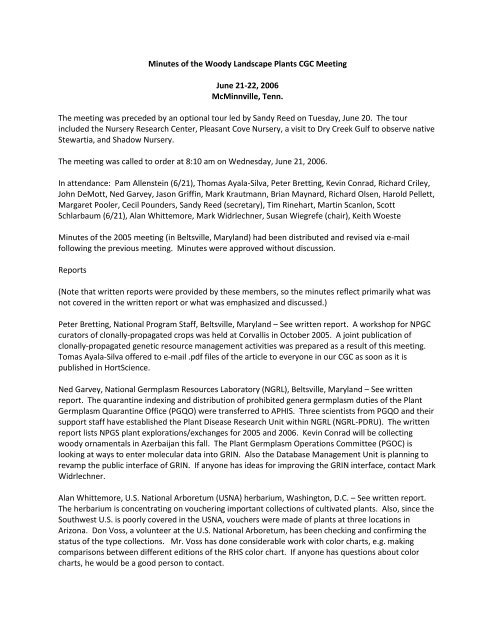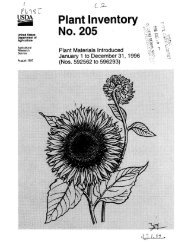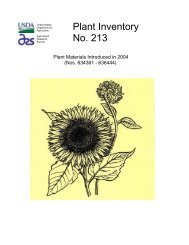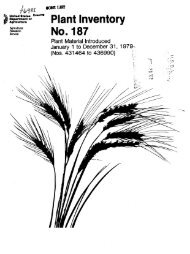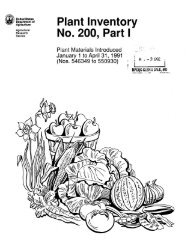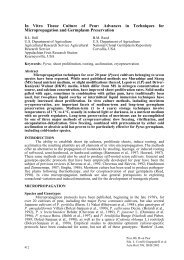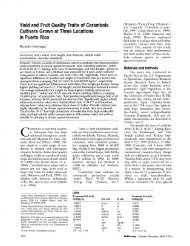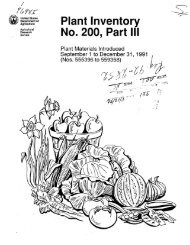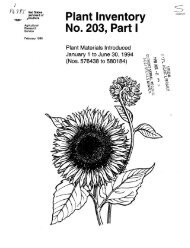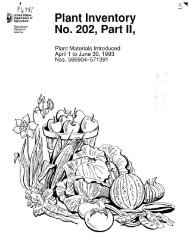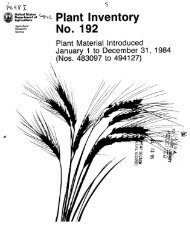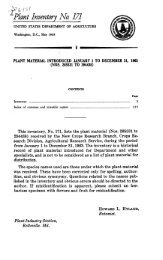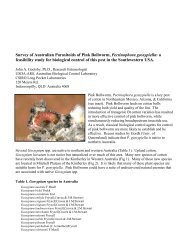Minutes of the Woody Landscape Plants CGC Meeting June 21-22 ...
Minutes of the Woody Landscape Plants CGC Meeting June 21-22 ...
Minutes of the Woody Landscape Plants CGC Meeting June 21-22 ...
- No tags were found...
Create successful ePaper yourself
Turn your PDF publications into a flip-book with our unique Google optimized e-Paper software.
Kevin Conrad, <strong>Woody</strong> <strong>Landscape</strong> Plant Germplasm Repository (WLPGR), Beltsville, Maryland – Seewritten report. The move from Glenn Dale, Maryland to <strong>the</strong> South Farm on <strong>the</strong> Beltsville campus isprogressing. The new mailing address <strong>of</strong> <strong>the</strong> WLPGR is:WLPGR FNPRUU.S. National Arboretum10300 Baltimore AveBldg 010A Rm 233Beltsville, Maryland 20705The new facility at South Farm is still being set up. Polyhouses are to be installed this summer byWLPGR staff. Deer fence has been purchased and installed.Tomas Ayala-Silva, Subtropical Horticulture Research Station, Miami, Florida – See written report.About 45 species <strong>of</strong> trees, shrubs and herbaceous perennials were collected in Puerto Rico in 2005.Approximately 80-85% <strong>of</strong> <strong>the</strong> material collected is already in <strong>the</strong> ground. There have been a lot <strong>of</strong>requests recently for ornamental sugarcane. Brazil has a good collection, but because <strong>of</strong> <strong>the</strong> CBD <strong>the</strong>reare problems acquiring this germplasm. Thailand also has a good collection, and is more amenable thatBrazil to exchange <strong>of</strong> germplasm.Cecil Pounders and Tim Rinehart, Thad Cochran Sou<strong>the</strong>rn Horticultural Laboratory, Poplarville,Mississippi – See written report. Hurricane Katrina destroyed three greenhouses and damaged severalo<strong>the</strong>rs. All buildings at <strong>the</strong> station suffered ro<strong>of</strong> damage. FEMA used <strong>the</strong> facility for several monthsafter Katrina. An article was recently published in HortScience outlining precautions that were taken toprotect germplasm during <strong>the</strong> hurricane. Tim Rinehart has his molecular marker laboratory up andrunning. He has been working with Hydrangea and Lagerstroemia, but is open to cooperative projectsfocusing on additional genera.Mark Widrlechner, North Central Regional Plant Introduction Station (NCRPIS), Ames, Iowa – See writtenreport. The NCRPIS currently has a backlog <strong>of</strong> material needing to be regenerated, so <strong>the</strong>re is currentlyrelatively little emphasis on acquiring new collections. <strong>Plants</strong> are moved from containers to <strong>the</strong> fieldquicker than previously, and cage-pollination is being used for seed regeneration. During <strong>the</strong> past year,images <strong>of</strong> many <strong>of</strong> <strong>the</strong> NCRPIS ornamental accessions were loaded onto <strong>the</strong> GRIN database. S<strong>of</strong>twarehas been developed that makes it easy to mass-load image files onto GRIN. In light <strong>of</strong> <strong>the</strong> Emerald AshBorer threat, a coordinated plan for <strong>the</strong> ex situ conservation <strong>of</strong> North American Fraxinus is being made.This involves <strong>the</strong> personnel from <strong>the</strong> NPGS, <strong>the</strong> NRCS, <strong>the</strong> U.S. Forest Service and <strong>the</strong> Canadian GeneticResources Program. A collecting strategy is currently being drafted.Keith Woeste, U.S. Forest Service, West Lafayette, Indiana – Hardwood Tree Improvement andRegeneration Center is a research and technology transfer unit. Work at <strong>the</strong> center involves finehardwoods, not ornamentals, but a few species overlap. They are working on developing molecularmarkers for Juglans and Quercus. They also have rooting research projects involving Prunus, Juglansand Quercus.National Clonal Germplasm Repository, Davis, California – See written report. Ed Stover was unable toattend <strong>the</strong> meeting.USDA National Germplasm Repository, Corvallis, Oregon – See written report. Nei<strong>the</strong>r Kim Hummer norJoseph Postman was able to attend <strong>the</strong> meeting.
Richard Criley, University <strong>of</strong> Hawaii, Manoa, Hawaii – There is a position in Public Horticulture at <strong>the</strong>Assistant Pr<strong>of</strong>essor level open at <strong>the</strong> University <strong>of</strong> Hawaii. For those interested in tropical plants,“Tropical Garden Flora” by Staples and Herbst was recently published and is a great resource. ISHS willbe hosting a symposium on woody landscape plants in <strong>the</strong> Czech Republic, probably in 2008.Margaret Pooler, U.S. National Arboretum, Washington, D.C. – Breeding work is continuing with Cercis,Lagerstroemia, Prunus, Syringa, Deutzia and Corylopsis. Breeding emphasis is on increased coldtolerance and smaller plant size. Interspecific hybridization and molecular markers are being utilized in<strong>the</strong> breeding program.Richard Olsen, U.S. National Arboretum, Washington, D.C. – Richard started work at <strong>the</strong> USNA in April2006. He is in position previously occupied by Denny Townsend. The emphasis <strong>of</strong> his research will be todevelop small trees for <strong>the</strong> urban environment.Pam Allenstein, North American Plant Collections Consortium (NAPCC) Coordinator, American PublicGardens Association, Wilmington, Delaware – See written report. The NAPCC has a recruiter network tohelp expand <strong>the</strong> NAPCC program. They are also working on a project to develop a distributed databasesystem that will allow a variety <strong>of</strong> incompatible database formats to be accessed to retrieve integratedresults. The American Association <strong>of</strong> Botanical Gardens and Arboreta (AABGA) <strong>of</strong>ficially changed itsname to <strong>the</strong> American Public Gardens Association (APGA). Pam was asked about whe<strong>the</strong>r <strong>the</strong>re wereany curatorial practices guidelines published on-line. She indicated that Tim Hohn had posted a set <strong>of</strong>guidelines on <strong>the</strong> web, but that <strong>the</strong>se were most likely outdated. (Note added later by Sandy Reed --<strong>the</strong>se are posted at: http://hort.edcc.edu/Curatorial%20Practices.pdf)HRI/ANLA – Mark Teffeau was unable to attend <strong>the</strong> meeting.Harold Pellett, <strong>Landscape</strong> Plant Development Center, Mound, Minnesota – Land in Minnesota wasrecently donated to <strong>the</strong> LPDC. This will be a great location for screening for cold tolerance. They startedplanting materials <strong>the</strong>re this spring. A small polyhouse and a potting shed have been set up at <strong>the</strong>Oregon station. Work with Buddleia and Weigela is continuing in cooperation with Cornell University.The first three introductions <strong>of</strong> <strong>the</strong> LPDC have been released. They are ‘Center Glow’ ninebark, ‘CenterStar’ clematis, and Silver Ball pear.Jason Griffin, J.C. Pair Horticultural Research Center, Wichita, Kansas – They have a young but growingnursery industry in Kansas. They need plants adapted to high pH soils. Also this area has extremewea<strong>the</strong>r conditions – hot summers and cold winters – that are a challenge to nursery producers.Sue Wiegrefe, University <strong>of</strong> Wisconsin, River Falls, Wisconsin – METRIA will be holding its biennialmeeting at University <strong>of</strong> Minnesota <strong>Landscape</strong> Arboretum in Chanhassen on <strong>June</strong> 26-28, 2006. (Note:Proceedings <strong>of</strong> this symposium are posted athttp://www.ces.ncsu.edu/fletcher/programs/nursery/metria.) The Morton Arboretum has developed anew strategic plan which includes continuing <strong>the</strong> tree improvement program.Susan reported on <strong>the</strong> Viburnum evaluation grant that she received in 2005. An intern was hired toevaluate 17 populations for phenology, disease and insect tolerance, and flower and fruitcharacteristics. All evaluations so far have been made on single plants, but she has started cuttingpropagation for replicated trials.
North American China Plant Exploration Consortium (NACPEC) – Martin Scanlon recently went on aNACPEC collecting trip to China. The Director <strong>of</strong> <strong>the</strong> Beijing Arboretum coordinated <strong>the</strong> trip for <strong>the</strong>m.The trip was a success and it set up good contacts for future trips. Alan Whittemore added that NACPEChas good contacts in China. For more information, contact Kevin Conrad, Martin Scanlon or Tony Aiello(Morris Arboretum).IssuesAcquisition – Ned Garvey indicated that <strong>the</strong> NPGS has a new protocol for bringing in plants from outside<strong>the</strong> U.S. APHIS is no longer involved at ports <strong>of</strong> entry; this is now under Homeland Security. <strong>Plants</strong> aresent to <strong>the</strong> Beltsville inspection center. It was suggested that someone from APHIS be invited to attendour next meeting.Peter Bretting provided an update on <strong>the</strong> situation with China. The main problem is that we don’t yetknow who <strong>the</strong> critical contact is for <strong>the</strong> CBD in China. We used to be able to get permission at <strong>the</strong>provincial level, but new legislation requires national level permission. However, we do seem to bemaking progress in this area.Ned Garvey explained that regardless <strong>of</strong> who is collecting plant material, it is necessary to get NationalAccess Permission from <strong>the</strong> country in which you want to collect. Differences between individuals,commercial interests, private institutions and <strong>the</strong> NPGS relate to what strings are attached to <strong>the</strong>material once it is brought back to <strong>the</strong> U.S. Sometimes <strong>the</strong> material comes with restrictions that do notmeet <strong>the</strong> guidelines <strong>of</strong> <strong>the</strong> NPGS. For example, permission may be given to collect and use in research,but not to distribute. This would not be compatible with NPGS’s mission and distribution policy.Mark Widrlechner addressed how <strong>the</strong> CBD issue affects Index Seminum material. He said that mostinstitutions will include a statement concerning CBD compliance. If <strong>the</strong> conditions are not acceptablefor NPGS, <strong>the</strong>n material should not be requested. Researchers might be able to accept material thatcurators could not; and, for ARS researchers, <strong>the</strong> Office <strong>of</strong> Technology Transfer should be consulted toclarify this.Ned Garvey added that when plants come in from commercial sources, NPGS will ask how materialswere collected and whe<strong>the</strong>r permission had been granted by <strong>the</strong> source country. Germplasm thatcomes in now <strong>of</strong>ten has a Material Transfer Agreement (MTA) attached.Peter Bretting’s report to this <strong>CGC</strong> includes <strong>the</strong> URL for <strong>the</strong> State Department site(http://www.state.gov/g/oes/rls/or/25962.htm) that gives information for collecting germplasm outside<strong>the</strong> U.S.Sue Wiegrefe questioned whe<strong>the</strong>r NAPCC is making sure all collections are free <strong>of</strong> restrictionsconcerning <strong>the</strong>ir distribution. It was suggested that when an institution applies for membership inNAPCC would be a good time to look at this issue. NAPCC is not policing this issue; it is up to eachinstitution as to how <strong>the</strong>y implement it.Mark Widrlechner brought up <strong>the</strong> fact that <strong>the</strong>re are some collections in <strong>the</strong> NPGS that have somerestrictions concerning <strong>the</strong>ir distribution and that this shows up in GRIN. He suggested that NAPCCorganizations also enter this information into <strong>the</strong>ir databases.
Peter Bretting said that, at <strong>the</strong> request <strong>of</strong> some foreign governments, <strong>the</strong> NPGS will maintain somecollections for safeguarding, but that we don’t distribute those collections. For example, we backupParaguay’s germplasm collection at Fort Collins. Also, at <strong>the</strong> request <strong>of</strong> <strong>the</strong> Plant Variety ProtectionOffice, we maintain PVP cultivars, but we do not distribute <strong>the</strong>m until <strong>the</strong> PVP certificate expires.Documentation/Retrieval – According to Pam Allenstein vouchering <strong>of</strong> NAPCC collections depends on<strong>the</strong> individual institution or collection. Kevin Conrad has helped some institutions with this at <strong>the</strong>irrequest. Alan Whittemore added that <strong>the</strong> USNA Herbarium is always glad to get vouchers <strong>of</strong> importantcollections, but <strong>the</strong>y may or may not be able to help with <strong>the</strong> vouchering. Pam Allenstein mentionedthat <strong>the</strong> federated schema associated with <strong>the</strong> new database querying system includes a place forentering whe<strong>the</strong>r <strong>the</strong> sample has been vouchered.Evaluation – The RFP for Evaluation <strong>of</strong> <strong>Woody</strong> <strong>Landscape</strong> Plant Germplasm was reviewed by <strong>the</strong>members in attendance. Main changes involved including links to our status report and to <strong>the</strong> full list <strong>of</strong>temperate and tropical genera with <strong>the</strong>ir ranks. Ned Garvey indicated that he would contact MarkBohning about adding <strong>the</strong> full ranking list. There was discussion as to whe<strong>the</strong>r <strong>the</strong>re should be aseparate <strong>CGC</strong> for tropicals, but <strong>the</strong> consensus was that this would just “cut <strong>the</strong> pie into smaller pieces”.It was decided that <strong>the</strong> priority rankings would be reviewed every 7 years, which means that <strong>the</strong> firstrevision will occur in 2009.Preservation – Kevin Conrad expressed concern about <strong>the</strong> long-term viability <strong>of</strong> <strong>the</strong> South Farm locationfor <strong>the</strong> WLPGR. The University <strong>of</strong> Maryland wants a spur <strong>of</strong> I-95 extended through South Farm. Theproperty belongs to <strong>the</strong> federal government and <strong>the</strong> Beltsville Area Office is opposed to <strong>the</strong> construction<strong>of</strong> <strong>the</strong> road. However, since <strong>the</strong> position <strong>of</strong> <strong>the</strong> WLPGR in <strong>the</strong> middle <strong>of</strong> a growing urban area makes itvulnerable, Kevin plans to back up <strong>the</strong> collection at o<strong>the</strong>r sites. These sites will include: <strong>the</strong> maincampus at <strong>the</strong> USNA in D.C.; public gardens in <strong>the</strong> D.C. area; and, <strong>the</strong> landscape at BARC. Richard Olsenemphasized that at <strong>the</strong> current time <strong>the</strong> South Farm in non-functional for his breeding purposes.Kevin wants to move <strong>the</strong> WLPGR in <strong>the</strong> direction <strong>of</strong> using cages and insect-mediated pollination for seedregeneration. A first attempt was made but due to wea<strong>the</strong>r conditions it was not as successful as hoped.The question was raised as to whe<strong>the</strong>r universities could be involved in woody germplasm preservation.Several people emphasized that universities are generally not interested in this work. Cooperativearrangements concerning germplasm preservation that were made in <strong>the</strong> past, such as <strong>the</strong>establishment <strong>of</strong> <strong>the</strong> four Regional Plant Introduction Stations about 55 years ago would probably notbe agreed upon currently. This is especially true for universities in growing metropolitan areas.Peter Bretting emphasized that <strong>the</strong>re are several issues involved here. First, <strong>the</strong> WLPGR budget isstrained. For any project working under a fixed budget, operational funds are reduced by 5 – 10%/yeardue to inflation and pay increases. This is what has happened with <strong>the</strong> WLPGR budget. Second, SouthFarm is federal land and <strong>the</strong>re is a certain amount <strong>of</strong> buffering that occurs when <strong>the</strong> land is owned by<strong>the</strong> federal government. To place germplasm elsewhere, we would need to have at least a 50-year leaseon <strong>the</strong> land and it is unlikely that universities would agree to that long a lease. Transfer <strong>of</strong> land requiresan act <strong>of</strong> Congress, and so changes in land ownership within <strong>the</strong> federal government do not happenquickly. He also mentioned that <strong>the</strong> Floral and Nursery Plant Initiative may need to be revisited. Forexample, in <strong>the</strong> 1996 document, <strong>the</strong>re was no mention <strong>of</strong> invasiveness, as this problem was not in <strong>the</strong>limelight. In addition, <strong>the</strong> industry needs to be made aware that without woody plant landscapegermplasm banks, plants can become extinct. He suggested that we revisit our status report to include
emerging issues, such as sudden oak death and Emerald Ash Borer. However, it is not <strong>the</strong> role <strong>of</strong> thiscommittee to provide input as to possible sources <strong>of</strong> funding for germplasm efforts.Mark Krautmann emphasized <strong>the</strong> need for this committee to make industry aware <strong>of</strong> <strong>the</strong> importance <strong>of</strong>germplasm maintenance. He suggested articles in industry publications and talks at trade shows toincrease awareness <strong>of</strong> this committee and its role. Sandy Reed and Kevin Conrad will work on gettingarticles written for trade magazines and industry newsletters. Mark Krautmann also suggested thatprivate nurseries should be included in <strong>the</strong> preservation <strong>of</strong> germplasm and that <strong>the</strong> committee shouldconsider how <strong>the</strong>y would rate a company’s qualifications as a site for a germplasm conservation. While<strong>the</strong>re was agreement from several members <strong>of</strong> <strong>the</strong> committee that a commercial nursery might be wellsuitedfor growing large populations, <strong>the</strong>re were concerns as to long-term commitments for privatecompanies. Mark Widrlechner said he had tried growing populations at nurseries for <strong>the</strong> purpose <strong>of</strong>long-term evaluation, but that all three nurseries were forced to end <strong>the</strong> relationship before <strong>the</strong>evaluations could be completed.The WLPGR has not sent any material yet to Fort Collins for cryostorage, but Mark Widrlechner has beenworking on cryostorage <strong>of</strong> willows. Gayle Volk at Fort Collins is looking for people to collaborate with on<strong>the</strong> cryostorage <strong>of</strong> vegetative materials.Multi-site options for storage <strong>of</strong> germplasm were discussed. The group was in consensus that back-upstorage <strong>of</strong> woody landscape plant germplasm is critical. According to Kevin Conrad, only 10% <strong>of</strong> <strong>the</strong>WLPGR material is currently backed up at Fort Collins.Use/Support/Awareness – Ned Garvey circulated a draft <strong>of</strong> <strong>the</strong> Associate Germplasm Collection policyfor <strong>the</strong> NPGS. Discussion centered on: <strong>the</strong> eventual need to include private collections; documentationthat CBD guidelines had been followed; and, <strong>the</strong> ability <strong>of</strong> institutions to distribute germplasm.Status Report Revisitation – The 2002 status report was circulated. Mark Widrlechner and MargaretPooler agreed to coordinate <strong>the</strong> revision <strong>of</strong> this report, with help from o<strong>the</strong>r committee members forparticular sections. Main changes suggested by <strong>the</strong> committee involved updating statistical data, addingin new threats to germplasm, updating status <strong>of</strong> WLPGR, and including information about project to linkdatabases. A target date <strong>of</strong> Sept. 1, 2006 for <strong>the</strong> draft revision was accepted.FutureMembership – Sandy Reed will send letter to all members <strong>of</strong> <strong>the</strong> WLP<strong>CGC</strong> asking if <strong>the</strong>y wish to remainon <strong>the</strong> committee. Based on replies, she will submit <strong>the</strong> revised membership list to Mark Bohning.Kevin Conrad will approach Michael Melendrez (New Mexico nurseryman) about joining <strong>the</strong> committee.Mark Krautmann will contact Bill Hendrix (Klehm Nursery) and Richard Criley will speak with Loren Oki(Univ. <strong>of</strong> California).Election <strong>of</strong> Secretary – Jason Griffin was elected Secretary.2007 <strong>Meeting</strong> – Tentative plans are to meet in conjunction with <strong>the</strong> FarWest Trade Show in Portland,Oregon. The pre-meeting tour would be on Wednesday, August <strong>22</strong>. On Thursday, Aug. 23, <strong>the</strong>committee would meet in <strong>the</strong> morning to mainly consider “house-keeping items” (reports, etc.) OnFriday morning, <strong>the</strong> committee would meet to discuss substantive issues. Industry leaders would beinvited to attend and participate in <strong>the</strong> Friday morning session. Afternoons would be left free for visiting
<strong>the</strong> trade show floor. Mark Krautmann will check with <strong>the</strong> Oregon Association <strong>of</strong> Nurserymen to see ifthis is suitable with <strong>the</strong>m and if a meeting room can be arranged.The meeting was adjourned at 11:10 am on Thursday, <strong>June</strong> <strong>22</strong>.
Report from <strong>the</strong> U. S. National Arboretum herbarium, 2006Alan T. WhittemoreCollecting: We continue to concentrate on vocher important collections <strong>of</strong> cultivated plants that includematerial used in important breeding projects, well-named cultivars and recently introduced germplasm.So far this year, we have made considerable collections from <strong>the</strong> National Arboretum. We continued tovoucher significant specimens in <strong>the</strong> Lagerstroemia breeding collection, and we reviewed our living andherbarium collections <strong>of</strong> Glenn Dale azaleas and pressed 31 specimens that had never been vouchered.We also collected several significant collections <strong>of</strong> cultivated plants, including Camellia species andcultivars from <strong>the</strong> American Camellia Society, and plants cultivated at <strong>the</strong> Boyce Thompson Arboretum(Superior AZ), <strong>the</strong> USDA Desert Legume Project (DELEP) (Tucson AZ), <strong>the</strong> University <strong>of</strong> Arizona CampusArboretum (Tucson AZ), and <strong>the</strong> National Aquarium (Baltimore MD). I also made collections related tomy research, primarily North American Celtis species.We continue to look for important living collections to voucher, especially unvouchered collections thatare in danger because <strong>of</strong> <strong>the</strong> retirement <strong>of</strong> curators or o<strong>the</strong>r reasons. We also want to broaden ourgeographical representation <strong>of</strong> ornamentals; currently we're strong in eastern United States, weakest in<strong>the</strong> Rocky Mountains and <strong>the</strong> interior southwest. We're glad to have input from <strong>the</strong> committee oncollections that we should consider working on.Significant collections received: We have labelled and databased 117 Cirsium specimens voucheringresearch by Tracey Slotta (USDA-Fargo ND), and we have labelled <strong>the</strong> vouchers from <strong>the</strong> 2004 Republic<strong>of</strong> Georgia germplasm trip by Paul Meyer (Morris Arboretum) and Joseph Postman (USDA-Corvallis).Type and standard collections: Volunteer Don Voss continues <strong>the</strong> arduous job <strong>of</strong> checking andconfirming <strong>the</strong> status <strong>of</strong> all <strong>of</strong> our type collection (currently we have 1906 specimens that are confirmedvalid types). We verified, labeled, and mounted all our backlog <strong>of</strong> cultivar Nomenclatural Standards (48cultivars). We currently hold standards for 830 cultivars.Databasing: We have added 1567 records to our specimen database in BGBase, about a third <strong>of</strong> <strong>the</strong>sebeing vouchers from east Asian germplasm trips. There are currently 45,233 herbarium specimens in<strong>the</strong> database. We hope <strong>the</strong> database will be accessible via <strong>the</strong> Web in <strong>the</strong> not-too-distant future, butwe have no target date for this.
Report to <strong>Woody</strong> <strong>Landscape</strong> Plant <strong>CGC</strong> 2006NCGR Corvallis - Major Accomplishments for 2005Prepared by Kim Hummer & Joseph Postman(Our unabridged, 30 page report complete with glossy colour pictures and circles and arrows andparagraphs can be found at: http://www.ars-grin.gov/cor/news/AnnualReport2005.pdf )Service1. The Repository received 145 new accessions during 2005. The total inventory increased by 989,which included new on-site back-up forms for primary inventory items. We loaded 4,401 images forActinidia, Fragaria, Rubus, Ribes, Vaccinium, Pyrus and Juglans plants, flowers or fruits.2. For <strong>the</strong> third year in a row, Bruce Bartlett, Plant Distribution Manager, broke records for distribution,shipping 4,640 items for 503 requests around <strong>the</strong> world. This is <strong>the</strong> largest number <strong>of</strong> accessionsdistributed in one year from <strong>the</strong> Corvallis Repository since establishment in 1981.3. The Repository hosted two meetings this past year: <strong>the</strong> 56th annual Western Pest and DiseaseConference on 11 and 12 January 2005, at Timberline Lodge, Government Camp, Oregon; and aworkshop for clonal curators in <strong>the</strong> National Plant Germplasm System held at <strong>the</strong> Corvallis Repository on2-3 October. More than 40 individuals attended from NPGS gene banks in Brownwood (2 people),Corvallis (17), Davis (5), Hilo (4), Geneva (6), Fort Collins (2), and Riverside (4). We had productivediscussions and hands-on technology exchanges on computer and database issues, screenhouse andfield collection management, in vitro and cryogenic methods, and molecular evaluations. A jointpublication <strong>of</strong> clonal activities to was prepared for submission to HortScience as a result <strong>of</strong> this meeting.4. Joseph Postman and his staff evaluated and documented information concerning <strong>the</strong> pear fieldcollection. A long, rainy spring season resulted in very high fungal disease incidence and provided anopportunity to add useful data to ongoing evaluations for pear leaf scab, fruit scab and Fabraea leafspot. A large number <strong>of</strong> accessions were identified as ei<strong>the</strong>r highly resistant or highly susceptible to<strong>the</strong>se diseases. In September and October, more than 1000 fruit photographs were taken and loaded toGRIN as image vouchers.5. The tissue culture lab provided in vitro materials for core collection cryopreservation to NCGRP - Ft.Collins. These materials will provide a cryogenic backup for our collections. At present <strong>the</strong> mint core iscryostored as are parts <strong>of</strong> <strong>the</strong> Pyrus, Ribes, Humulus, Fragaria, and Rubus core collections. We arecollaborating with NCGRP on <strong>the</strong> cryostorage <strong>of</strong> <strong>the</strong>se collections.Research1. Barbara Reed and graduate student Hailu Aynalem developed a computer analysis technique toscreen in vitro-stored cultures. The results correlated well with our standard visual screening methodbut is not practical for direct use at this time. Dr. Reed and visiting scientist Dr. Sandhya Guptaoptimized vitrification and encapsulation cryopreservation protocols for several accessions <strong>of</strong> Rubus.These protocols, in addition to <strong>the</strong> slow-cooling protocol already in place, provide several options forcryostorage <strong>of</strong> <strong>the</strong> Rubus collection.
2. Nahla Bassil and her laboratory team developed 51 additional EST-SSR markers in Fragaria: 37 from‘Strawberry Festival’, in collaboration with Kevin Folta and Kim Lewers, and 14 from ‘Yellow Wonder’ incollaboration with Janet Slovin. In blueberry, Nahla Bassil and Peter Boches, her graduate student,developed SSR fingerprints for 69 important blueberry cultivars using 31 SSR loci, and uploaded <strong>the</strong>results for 54 cultivars using 25 SSRs to GRIN at http://www.arsgrin.gov/cgibin/npgs/html/eval.pl?4928243. Kim Hummer and Nahla Bassil collaborated with Ing. Jose Mota, Isabel Arnas and o<strong>the</strong>r scientists in<strong>the</strong> Azores, under an Azores Cooperative Initiatives Grant. Samples <strong>of</strong> unknown apple and pear cultivarsgrowing in <strong>the</strong> Azores were sent for molecular marker analysis to compare to known, standardPortuguese and American cultivars. The Repository laboratory identified eight sets <strong>of</strong> synonyms in 18apple and 9 pear genotypes grown in <strong>the</strong> Azores using 11 microsatellite markers from both genera.4. Joseph Postman, in collaboration with Nahla Bassil, implemented phytoplasma testing protocols forrepository genera. They evaluated two sets <strong>of</strong> primers for nested PCR and examined suspectedphytoplasma infected clones in Corylus, Fragaria, Pyrus, and Vaccinium to verify <strong>the</strong>ir usefulness aspositive controls. They conducted trials for appropriate sampling date, tissue source and effectiveness <strong>of</strong>universal primers. Universal primers P1/P7 for initial PCR and R16F2n/R16R2 for <strong>the</strong> nested reactionworked well for all samples except Vaccinium. They obtained good results with appropriate size bandsfor hazelnut stunt, strawberry multiplier, strawberry greenpetal, strawberry fruit phylloidy, pear decline,and cranberry falseblossom). Sampling dates after mid-September were best. Leaf petioles were <strong>the</strong>tissue <strong>of</strong> choice. Super-core strawberry collection was assayed (48 clones) and nearly half tested positivefor phytoplasmas.
Report <strong>of</strong> <strong>the</strong> USDA National Clonal Germplasm Repository (NCGR), Davis, CAEd Stover, Research Leader and CuratorFunding and Staffing updateDavis-NCGR funding has been essentially unchanged for FY 05-06, despite significant “salary creep”.Clay Weeks, <strong>the</strong> Prunus Horticulturist, has been on extended medical leave since August 2005 and isexpected to be out until at least August 2006. During <strong>the</strong> second quarter <strong>of</strong> FY 06, we lost a biologicalscience technician (Joe Wehrheim), and this salary permits us to maintain a sound fiscal basis. Loss <strong>of</strong><strong>the</strong>se two people has slowed progress in characterizing our collections.Funding <strong>of</strong> $106,000 has been obtained through five grants in 2006, with expectation <strong>of</strong> at least oneadditional year <strong>of</strong> funding <strong>of</strong> similar amounts from each source. $56,600 was received from ViticultureConsortium West for development <strong>of</strong> a National Grape Registry, which will be a user friendly on-linedatabase <strong>of</strong> all grape genetic resources in <strong>the</strong> US and was listed as an industry priority in recent ARSGrape Industry workshops. $20,000 was obtained through <strong>the</strong> Nursery Industry Advisory Board formolecular fingerprinting <strong>of</strong> Prunus cultivars. $10,050 in 2006 was provided by <strong>the</strong> California Fig AdvisoryBoard for assessing phenology and fruit quality characteristics <strong>of</strong> many fig accessions ($10,800 wasawarded in 2005). $2,140 was received from <strong>the</strong> Missouri Botanical Garden to assess genetic diversityin Eastern Himalayan walnuts. Un<strong>of</strong>ficial notice has been received that we will also be funded $18,000by <strong>the</strong> Walnut Marketing Board, to assess resistance to crown gall across <strong>the</strong> entire NCGR Juglanscollection, in collaboration with Davis ARS Plant Pathologist Dan Kluepfel.Maintenance <strong>of</strong> Collections- The Davis NCGR has assigned a “Crop Point Person” to each collection sothat each crop genus (and its relatives) has one person to focus on it. Detailed cultural managementplans were developed and both fruit and budwood quality were widely praised as being <strong>the</strong> best in DavisNCGR history. With considerable help from National Program funding, micro-irrigation is now in placeacross most <strong>of</strong> <strong>the</strong> nursery/greenhouse/screenhouse area.Vitis- 93% <strong>of</strong> <strong>the</strong> Vitis collection now resides in screenhouses to protect against Pierce’s Disease.Equipment for virus screening was purchased using National Program funds, and will be used to assess400 accessions in 2006.Juglans- With input from <strong>the</strong> Juglans <strong>CGC</strong> we have stabilized some accessions which were in declineand have developed a management plan that provides fairly normal cropping on part <strong>of</strong> each tree fornut evaluation, while producing excellent budwood for distribution, and maintaining tight spacing forland use efficiency.Actinidia- <strong>Plants</strong> in our Actinidia collection have performed very poorly. Investigations anddiscussions confirm that site selection was inappropriate for plants in this genus. As appropriate andpossible, plants have been repropagated, recollected, or dug up. They will be transferred to a new,better drained site in 2006.Acquisition <strong>of</strong> new accessionsFrom January 2005 through May 2006, Davis NCGR accepted 628 new accessions. Several species arenew to <strong>the</strong> NPGS, and likely were never previously grown in <strong>the</strong> US.Distribution <strong>of</strong> materialIn 2005 Davis NCGR had <strong>the</strong> largest germplasm distribution in its history. A total <strong>of</strong> 3027 accessionorders were delivered to customers. Already, 2781 accessions have been distributed in 2006, suggestinga new record for distributions is likely this year.
ResearchVitis phylogeny project – Cluster and principal component analyses <strong>of</strong> both microsatellite (18 loci) andALFP (6 primer combinations containing 791 polymorphic characters) data have been completed. Amanuscript on genetic diversity and differentiation within and between different species, series, andsub-genera will be completed in 2006. Microsatellite data across 18 loci and 351 accessions comprising52 taxa <strong>of</strong> Vitis are ready for uploading on to GRIN.Plum and apricot SSRs - Sixteen microsatellite loci have been used to fingerprint 500 plum and apricotaccessions.Ficus SSRs- Twelve microsatellite loci have been used to fingerprint 1<strong>22</strong> fig accessions. The entirecollection will be completed in 2006. It is likely that a number <strong>of</strong> accessions will be found to beduplicates. Olea SSRs- Sixteen microsatellite loci have been used to fingerprint 60 olive accessions. Theentire collection will be completed soon. In collaboration with UC Santa Barbara, <strong>the</strong> National ParkService, and UC Davis his work is being extended to evaluating identities <strong>of</strong> early olive introductions intoCalifornia.Punica AFLPs- AFLP analysis has been used to assess genetic diversity within our pomegranatecollection. Despite <strong>the</strong> diverse origins <strong>of</strong> our individual accessions, diversity was found to be very low.Iberian grape SSRs- SSR fingerprints were taken on ~100 purported Iberian grape accessions and dataare being shared with our Spanish and Portuguese counterparts to verify identities.Vitis characterization-Conducted <strong>the</strong> first year <strong>of</strong> a study to characterize phenology, fruit quality andyield in 50 Iberian Vitis accessions.Olea characterization-Detailed data in phenology and morphology were collected on our entire Oleacollection in 2005-06. Data collection will be repeated in 2006-07.Ficus characterization-Detailed data on phenology and fruit quality were collected on a significantsubset <strong>of</strong> <strong>the</strong> fig collection.Publications:Albrigo, L., H. Beck, L. Timmer, and E. Stover. 2005. Development and testing <strong>of</strong> a recommendationsystem to schedule copper sprays for citrus disease control. J. ASTM International 2(9): (in press).Aradhya M., J. Dangl, B. Prins, and E. Stover. 2005. Use <strong>of</strong> genetic markers in grape at <strong>the</strong> NationalClonal Germplasm Repository in Davis, California. First International Grape Genomics Symposium p.62.(abstract).Aradhya M., J. Dangl, B. Prins, and E. Stover. 2005. Use <strong>of</strong> genetic markers in grape at <strong>the</strong> NationalClonal Germplasm Repository in Davis, California. Proceedings First International Grape GenomicsSymposium (submitted).Aradhya, M.K., Potter, D., and Simon, C.J. 2006. Cladistic Biogeography <strong>of</strong> Juglans (Juglandaceae) basedon chloroplast DNA intergenic spacer sequences. In Darwin’s Harvest – New approaches to <strong>the</strong> origins,
evolution, and conservation <strong>of</strong> crops. Motley, T.J., Zerega, N., and Cross, H. (eds.). Columbia UniversityPress, New York, 143-170.Aradhya, M.K. Potter, D., and Simon, C.J. 2006. Molecular Phylogeny and biogeography <strong>of</strong> <strong>the</strong> walnutgenus Juglans (Juglandaceae). Botanical Journal <strong>of</strong> <strong>the</strong> Linnean Society (in review).Aradhya, M.K., Prins, B.H., Dangl, G.S., Simon, C.J., and Stover, E. 2005. Genetic diversity andphylogeographic structure <strong>of</strong> <strong>the</strong> genus Vitis: implications for conservation. Abstract submitted to <strong>the</strong>First International Conference on Crop Wild Relative Conservation and Use, Wednesday 14th - Saturday17th September 2005, Agrigento, Sicily, Italy.Bhat, R. G., Colowit, P. M., Tai, T. H., Aradhya, M. K., and Browne, G. T. 2006. Genetic and pathogenicvariability in Phytophthora cactorum affecting fruit and nut crops in California. Plant Disease (in press).Boman, B., Zekri, M., Stover, E. 2005. Methods for managing salinity in citrus production.HortTechnology 15:<strong>21</strong>-26.Brenner, D.M., T. Ayala-Silva, B. Hellier, K. E. Hummer, M. Jenderek, L. F. Marek, J. B. Morris, R. Nelson,K. R. Reitsma, L. D. Robertson, S.M. Stieve, E.W. Stover and M.P. Widrlechner. 2005. Genetic resources<strong>of</strong> Omega-3 fatty acid crops. Soil and Crop Sci. (abstract).Ferguson, L., E. Stover, and C. Crisosto. 2005. Problems in fig production and physiology. ThirdInternational Symposium on Fig p. 37. (abstract).Hummer, K.E. and E. Stover. 2005. Trends and fashions in fruit cultivar production. HortTechnology15: 490-491.Motley, T.J., Cross, H., Zerega, N., and Aradhya, M.K. 2006. Appendix II. Molecular analyses. In Darwin’sHarvest – New approaches to <strong>the</strong> origins, evolution, and conservation <strong>of</strong> crops. Motley, T.J., Zerega, N.,and Cross, H. (eds.). Columbia University Press, New York, 370-378.Postman, J., K. Hummer, E, Stover, R. Krueger, P.Forsline, L.J. Grauke, F. Zee, T. Ayala-Silva, and B. Irish.2006. Fruit and nut genebanks in <strong>the</strong> US National Plant Germplasm System. HortScience (in press).Stover, E. and M. Aradhya. 2005. Fig genetic resources and research at <strong>the</strong> U.S. National ClonalGermplasm Repository in Davis, California. Third International Symposium on Fig p. 18. (abstract).Stover, E. and M. Aradhya. 2005. Fig genetic resources and research at <strong>the</strong> U.S. National ClonalGermplasm Repository in Davis, California. Acta Hort. (submitted).Stover, E. and M. Aradhya. 2005. Fig genetic resources and research at <strong>the</strong> U.S. National ClonalGermplasm Repository in Davis, California. Acta Hort. (submitted).Stover, E., M. Aradhya, C. Crisosto, and L. Ferguson. 2006. Screening <strong>the</strong> U.S. national fig collection forpotential fresh fruit genotypes. HortScience (abstract).Stover, E., M. Aradhya, and L. Ferguson. 2005. The fig: overview <strong>of</strong> an ancient fruit. HortScience 40:953(abstract).
Stover, E., M. Aradhya, L. Ferguson, and C.H. Crisosto. 2006. The fig: overview <strong>of</strong> an ancient fruit. J.Amer. Soc. Pomol. (submitted).Stover, E., M. Aradhya, B. Prins, J. Dangl, and P. Cousins. 2006. Vitis genetic resources and research at<strong>the</strong> U.S. National Clonal Germplasm Repository in Davis, California. Ninth International Conference onGrape Genetics and Breeding (abstract).Stover, E., M. Aradhya, C. Weeks, and P. Forsline. 2006. Prunus genetic resources and research at <strong>the</strong>U.S. National Clonal Germplasm Repository in Davis, California. Third International Rosaceae GenomicsSymposium (abstract).Stover, E., W, Castle, and C.C.T. Chao. 2005. Trends in U.S. sweet orange, grapefruit, and mandarin-typecultivars. HortTechnology 15:501-506.Stover, E.W., Greene D.W. 2005. Environmental effects on <strong>the</strong> performance <strong>of</strong> foliar applied plantgrowth regulators. HortTechnology 15:<strong>21</strong>4-2<strong>21</strong>.
Report <strong>of</strong> <strong>the</strong> SHRS Miami to <strong>the</strong> WLP<strong>CGC</strong> for 2005-6Prepared by Alan Meerow and Tomás Ayala-SilvaFrom May 2-13, 2005, horticulturist Tomas Ayala-Silva and Geneticist Alan W. Meerow visited PuertoRico as part <strong>of</strong> a two man team plant exploration. The main focus <strong>of</strong> this collection trip was Tabebuiahaemantha, a rare Puerto Rican endemic that has many features <strong>of</strong> interest to horticulture. Sixty-twocollections including 45 species <strong>of</strong> trees, shrubs and herbaceous perennials were obtained. The team,sponsored by <strong>the</strong> Plant Exploration Office (PEO) and assisted by Dr. Ricardo Goenaga and Dr. Brian Irish(TARS, Mayaguez), assessed many new subtropical/tropical species for evaluation and possibleintroduction.New field plantings were established for three populations each <strong>of</strong> Tabebuia haemantha and T.heterophylla, one <strong>of</strong> T. chrysotricha and 4 populations <strong>of</strong> Thespesia grandiflora, all material collected inPuerto Rico by Tomas Ayala-Silva and Alan Meerow.Three hurricanes in succession caused a great <strong>of</strong> damage to <strong>the</strong> collections at <strong>the</strong> SHRS. We lostapproximately 10% <strong>of</strong> accessions, and several evaluation fields <strong>of</strong> ornamentals were severely damaged.The Repository hosted two meetings this past year: <strong>the</strong> annual Friends <strong>of</strong> Chapman Field meeting on 11February 2005, at <strong>the</strong> repository in Miami, Florida; and <strong>the</strong> Tropical Flowering Tree Society meeting heldat <strong>the</strong> Miami Repository on March 12, 2005.Approximately 100 woody ornamental distributions were made from <strong>the</strong> National GermplasmRepository.An outstanding subtropical ornamental shrub, Polygala myrtifolia ‘Chapman Field’ was released this pastyear, and we have received numerous requests for material. Unfortunately, severe hurricane damage to<strong>the</strong> stock planting delayed distribution <strong>of</strong> cuttings until this summer.Post-doc Margarita Mauro Herrera isolated 13 WRKY gene loci from Cocos nucifera and is using <strong>the</strong>m tocharacterize ornamental coconut germplasm. She is also in <strong>the</strong> process <strong>of</strong> isolating resistance genehomologs (RGHs) from coconut as well. We hope that to be able to identify alleles associated withvarieties that are resistant to <strong>the</strong> lethal yellowing phytoplasma..We established replicated field evaluations <strong>of</strong> several seedling selections <strong>of</strong> <strong>the</strong> ornamental shrubTecoma guarume for possible cultivar release.Alan Meerow completed analysis <strong>of</strong> 83 Plumeria cultivars using <strong>21</strong> microsatellite DNA loci, andnumerous Halesia tetraptera accessions at <strong>the</strong> <strong>Woody</strong> Ornamnetals Germplasm Collection in Glen Dale,MD (a collaborative project with Mark Roh). Analysis <strong>of</strong> Puerto Rican Zamia populations with 20 SSR lociis ongoing.Scientists associated with <strong>the</strong> ornamentals CRIS project at <strong>the</strong> Miami NCGR authored or co-authored 4abstracts, 6 non-refereed proceedings or trade journal, and 13 refereed publications.
USDA/ARSNational Germplasm Resources LaboratoryReport to PGOC, RTACs and <strong>CGC</strong>s2006The National Germplasm Resources Laboratory (NGRL), located in <strong>the</strong> Plant Sciences Institute at <strong>the</strong>Henry A. Wallace Agricultural Research Center in Beltsville, MD, supports <strong>the</strong> acquisition, introduction,documentation, evaluation, and distribution <strong>of</strong> germplasm by <strong>the</strong> National Plant Germplasm System(NPGS) and o<strong>the</strong>r components <strong>of</strong> <strong>the</strong> U.S. National Genetic Resources Program (NGRP). The Laboratoryis comprised <strong>of</strong> <strong>the</strong> Germplasm Resources Information Network/Database Management Unit(GRIN/DBMU), <strong>the</strong> Plant Exchange Office (PEO) and <strong>the</strong> Plant Disease Research Unit (PDRU) whosefunctions and procedures are provided below. The Laboratory also facilitates <strong>the</strong> activities <strong>of</strong> <strong>the</strong> CropGermplasm Committees that advise components <strong>of</strong> <strong>the</strong> NPGS on a variety <strong>of</strong> matters.Plant Exploration and Exchange ProgramThe PEO supports <strong>the</strong> collection <strong>of</strong> germplasm for <strong>the</strong> NPGS through <strong>the</strong> management <strong>of</strong> a PlantExploration and Exchange Grant Program. Plant explorations involve field collection <strong>of</strong> germplasm notavailable in any germplasm collections, while plant exchanges are expeditions to arrange exchange <strong>of</strong>germplasm already conserved in foreign genebanks. Annual guidelines for developing plant explorationand exchange proposals are prepared by <strong>the</strong> PEO and distributed to researchers.An extensive review procedure is used to assess <strong>the</strong> relevance <strong>of</strong> <strong>the</strong> proposals to <strong>the</strong> NPGS needs and<strong>the</strong> likelihood that <strong>the</strong> proposed explorations or exchanges will accomplish <strong>the</strong>ir stated objectives.Before submission, proposals are reviewed by <strong>the</strong> appropriate <strong>CGC</strong> or o<strong>the</strong>r crop experts. Aftersubmission to <strong>the</strong> PEO, proposals are reviewed by a subcommittee <strong>of</strong> <strong>the</strong> NPGS Plant GermplasmOperations Committee (PGOC). The PEO <strong>the</strong>n evaluates <strong>the</strong> proposals and <strong>the</strong> PGOC reviews and makesrecommendations on funding to <strong>the</strong> ARS National Program Staff (NPS).All foreign explorations supported by PEO comply with <strong>the</strong> provisions <strong>of</strong> <strong>the</strong> Convention on BiologicalDiversity on access and benefit sharing related to genetic resources. Prior informed consent to collectgenetic resources is obtained from <strong>the</strong> appropriate host country authorities before <strong>the</strong> exploration takesplace. The permission includes agreement on <strong>the</strong> benefits to <strong>the</strong> host country associated with access togenetic resources. The PEO is involved in most requests to foreign governments for permission forcollecting and negotiates <strong>the</strong> terms <strong>of</strong> agreements when necessary. Foreign explorations are alwaysconducted in cooperation with scientists from <strong>the</strong> host country and cooperation with <strong>the</strong> nationalgenetic resources programs is strongly encouraged. Germplasm obtained on explorations is shared by<strong>the</strong> NPGS and <strong>the</strong> host country.(Attachments: FY 05 and 06 Plant Explorations and Exchanges)Facilitation <strong>of</strong> Germplasm ExchangeThe PEO assists NPGS personnel and o<strong>the</strong>r scientists in acquiring germplasm from scientists and privatecitizens, foreign national and international genebanks, domestic and foreign explorations, and specialprojects and agreements. The PEO also helps to expedite <strong>the</strong> distribution <strong>of</strong> germplasm from <strong>the</strong> NPGSto scientists and o<strong>the</strong>r genebanks.
In FY 05, PEO assisted with <strong>the</strong> distribution <strong>of</strong> 35,590 items to 60 countries. PEO also assisted withimporting 81 shipments containing 3,105 items from 34 countries.PI DocumentationSince 1898, Plant Introduction (PI) numbers have been used as unique identifiers for accessionsincorporated into <strong>the</strong> NPGS. In earlier times, PI numbers were automatically assigned to all materialreceived by <strong>the</strong> Plant Introduction Office, a predecessor <strong>of</strong> <strong>the</strong> PEO. Currently, before PI numbers areassigned, NPGS curators first evaluate <strong>the</strong> passport data, and grow and observe new accessions to verifyuniqueness and rationale for preservation in <strong>the</strong> NPGS. For this reason, curators usually assign a localidentifying number to an accession until a decision is made to assign a PI number. When a decision isreached to assign a PI number to an accession, <strong>the</strong> curators are now requested to contact Mark Bohningfor assignment <strong>of</strong> <strong>the</strong> next sequential number(s).In addition, ARS and <strong>the</strong> Crop Science Society <strong>of</strong> America (CSSA) have an agreement that all releasedcultivars, germplasm, parental lines, genetic stocks, and genetic mapping populations registered by <strong>the</strong>CSSA be preserved in <strong>the</strong> NPGS and assigned a PI number.The NGRL also assigns PI numbers to plants that have received Plant Variety Protection (PVP) from <strong>the</strong>Plant Variety Protection Office.International Collaboration to support conservation and exchange <strong>of</strong> plant genetic resourcesPEO works with o<strong>the</strong>r US and international programs to support plant germplasm conservation andexchange worldwide.During <strong>the</strong> past year, PEO continued to collaborate with <strong>the</strong> National Department <strong>of</strong> Genetic Resourcesand Biotechnology (DENAREF) <strong>of</strong> <strong>the</strong> National Institute <strong>of</strong> Agricultural Research (INIAP) in Ecuador, <strong>the</strong>Organization <strong>of</strong> Farmers and Indigenous Peoples <strong>of</strong> Cotacachi (UNORCAC), and <strong>the</strong> USDA/FAS on a P.L.480 – funded project to support complementary (ex situ and on-farm) conservation and increasedutilization <strong>of</strong> agro-biodiversity in native farming communities in Cotacachi, Ecuador.The PEO also collaborated with USDA/FAS and USDA/ARS/OIRP to develop joint germplasm collection,conservation and maintenance programs in Jordan, Morocco, Tunisia, Peru, Bangladesh, Sri Lanka,Uzbekistan, Pakistan, Kazakhstan, Guyana, Georgia and Azerbaijan using US Food for Peace and o<strong>the</strong>rprograms.Since 2002, PEO has been collaborating with <strong>the</strong> plant genetic resources programs <strong>of</strong> <strong>the</strong> eight CentralAsia and <strong>the</strong> Caucasus countries: Kazakhstan, Kyrgyzstan, Tajikistan, Turkmenistan, Uzbekistan, Armenia,Georgia and Azerbaijan. This program is organized by ICARDA (International Center for Research in <strong>the</strong>Dry Areas) and <strong>the</strong> focus is on development <strong>of</strong> national plant inventories, staff training, and plantexploration.PEO is collaborating with <strong>the</strong> International Center for Tropical Agriculture (CIAT) to developGeographical Information System (GIS) technology to guide <strong>the</strong> collection <strong>of</strong> germplasm on plantexplorations. Projects are planned in Guatemala and Paraguay.
Contact Information:Ned Garvey (ngarvey@ars-grin.gov, (301) 504-7511)Karen Williams (kwilliams@ars-grin.gov, (301) 504-54<strong>21</strong>)The Germplasm Resources Information NetworkThe mission <strong>of</strong> <strong>the</strong> Database Management Unit (DBMU) is to develop and maintain information systemsfor <strong>the</strong> National Genetics Resources Program comprised <strong>of</strong> plants, animals, microbes, and invertebrates.We have completed <strong>the</strong> development <strong>of</strong> a new interface for <strong>the</strong> plant database and will continue toenhance that system when specific needs arise. The first version <strong>of</strong> <strong>the</strong> National Animal GermplasmProgram system has been completed and is currently being used in a production mode. The DBMU hasnow begun developing a requirements document for version two.Recent statistics for data in <strong>the</strong> plant database include:Over 80,000 taxonomic names (including synonyms)470,946 accessions representing 11,839 species and 1,916 genera1,543,563 inventory records1,235,671 germination records6,313,140 characteristics/evaluation recordsOver 106,000 ImagesGermplasm accessions acquired by <strong>the</strong> National Plant Germplasm System (NPGS) since <strong>the</strong> effectivedate <strong>of</strong> <strong>the</strong> Convention on Biological Diversity continue to be flagged in <strong>the</strong> database with appropriatedisclaimers and MTA’s. These agreements are displayed with accession passport data and automaticallyprinted on GRIN generated packing slips when accessions are distributed. During <strong>the</strong> past year, <strong>the</strong>DBMU continued to provide support to NPGS site personnel and assisted NPGS sites in loading passportdata, evaluation data, distribution information and images into <strong>the</strong> databaseGRIN was demonstrated at several Crop Germplasm Committees and commodity meetings along withscientists visiting NGRL throughout <strong>the</strong> year. The Directory <strong>of</strong> NPGS Personnel and Crop GermplasmCommittees continues to be maintained on <strong>the</strong> GRIN Web page in a PDF format.A GRIN site meeting will be held in September in Geneva, NY. Many issues will be discussed about <strong>the</strong>GRIN site s<strong>of</strong>tware and <strong>the</strong> public system. Recommendations from that meeting will be incorporatedinto <strong>the</strong> system.In September <strong>of</strong> 2005 <strong>the</strong> NP301 began its second cycle and a stake holders meeting was held nearBaltimore. Two major issues regarding GRIN were identified including:1.) GRIN needs to handle molecular data being generated on NPGS accessionsand needs to interact better with <strong>the</strong> plant genome databases2.) The GRIN public web interface and s<strong>of</strong>tware need to be rewritten in order to meet users needsTo address <strong>the</strong>se issues a sub-committee <strong>of</strong> NPGS curators has been developed to advise us on how toincorporate molecular data into GRIN. They have already laid out <strong>the</strong> structures that need to be added
to GRIN and <strong>the</strong> DBMU has begun to create <strong>the</strong> new tables and s<strong>of</strong>tware to manage and display <strong>the</strong> datato <strong>the</strong> user community.A public interface committee has also been established and will consist <strong>of</strong> NPGS personnel to advise <strong>the</strong>DBMU on improving <strong>the</strong> public interface to GRIN. The committee will solicit input from <strong>the</strong> <strong>CGC</strong>s ando<strong>the</strong>r stakeholders <strong>of</strong> <strong>the</strong> system.The DBMU is also working with <strong>the</strong> international community to make <strong>the</strong> GRIN data available through abiodiversity portal which will allow users to search multiple databases at <strong>the</strong> same time.The GRIN system was available 98% <strong>of</strong> <strong>the</strong> time on a 24 hour a day and 7 day a week schedule. Access to<strong>the</strong> database through <strong>the</strong> web pages continues at a brisk pace. Over <strong>the</strong> last year, <strong>the</strong>re were 154,570unique host computers that accessed <strong>the</strong> GRIN database. This accounted for 544,043 visits to <strong>the</strong> data.We always encourage users to send any comments on <strong>the</strong> public interface by email to dbmu@arsgrin.gov.The current version <strong>of</strong> pcGRIN will continue to be supported by <strong>the</strong> DBMU. Any new pcGRIN s<strong>of</strong>twarewill be a version <strong>of</strong> <strong>the</strong> national GRIN system that can operate on a personal computer utilizing <strong>the</strong> sameDatabase Management System and development tools to reduce maintenance costs.Two Sun Microsystem computers were replaced in 2001, one that supports <strong>the</strong> web server and siteusers and one that is used specifically for <strong>the</strong> databases. The databases reside on a separate computerto provide additional security. We also purchased two additional small Sun Microsystems workstationsthat are used for database development and for testing new operating systems prior to release to <strong>the</strong>user community. Additionally, one terabyte <strong>of</strong> disk space was purchased to ensure adequate space isavailable for increases in characteristic, evaluation, and image data.Security for <strong>the</strong> computer and databases are always being reviewed and monitored for intrusion bythose who may attempt to corrupt web pages or to destroy data. The system is protected by a firewalland all data are backed up at onsite and <strong>of</strong>fsite locations. We keep backups at several local <strong>of</strong>fsitelocations and one at Ft. Collins, CO, for long term storage. The computer system has an UninterruptiblePower Supply for short term power outages and a diesel generator for long term power outages. Thebuilding is now locked with access permitted by ei<strong>the</strong>r a building security person or a card key. Thecomputers are in a locked room that is monitored for temperature on a 24 hour, 7 days a weekschedule.Crop Germplasm Committee FacilitationSince January 1, 2005, over thirty <strong>of</strong> <strong>the</strong> 40 Crop Germplasm Committees (<strong>CGC</strong>) have met. An NGRLrepresentative was present at most <strong>of</strong> <strong>the</strong> meetings to help facilitate <strong>the</strong>ir activities. Summaries <strong>of</strong> eachmeeting are prepared and distributed to appropriate National Program Leaders, NGRL staff and o<strong>the</strong>rNPGS personnel. The committees continue to provide advice on all aspects <strong>of</strong> <strong>the</strong> NPGS includingidentifying gaps and duplications in <strong>the</strong> collections, germplasm maintenance and evaluation, quarantineissues and maintaining updated versions <strong>of</strong> <strong>the</strong> crop vulnerability reports. The 10th biennial meeting <strong>of</strong><strong>the</strong> <strong>CGC</strong> Chairs will be held in Ames, IA <strong>June</strong> 6-7, 2006. This will be in conjunction with <strong>the</strong> RegionalTechnical Advisory Committees and <strong>the</strong> Plant Germplasm Operations Committee. This meeting providesan opportunity for Chairs to hear presentations on <strong>the</strong> status <strong>of</strong> NPGS sites, plant germplasm exchange,international issues, preservation and utilization, <strong>the</strong> molecular characterization <strong>of</strong> accessions,
interactions between curators and <strong>CGC</strong>s and plant quarantine issues. It also allows <strong>the</strong> Chairs to meetand interact with each o<strong>the</strong>r, NPGS managers and curators, and invited guests from ARS, o<strong>the</strong>rgovernment agencies, and non-government organizations.Plant Disease Research UnitEffective October 1, 2005, <strong>the</strong> responsibilities for <strong>the</strong> quarantine indexing and distribution <strong>of</strong> prohibitedgenera germplasm that were performed by <strong>the</strong> USDA-ARS, Plant Germplasm Quarantine Office (PGQO)in Beltsville MD were transferred to <strong>the</strong> USDA Animal and Plant Health Inspection Service-Plant HealthPrograms (APHIS-PHP). Three scientists from PGQO and <strong>the</strong>ir support staff have established <strong>the</strong> PlantDisease Research Unit within NGRL (NGRL-PDRU). The mission <strong>of</strong> NGRL-PDRU is to investigatepathogens and diseases <strong>of</strong> quarantine significance that occur in clonal plant germplasm that must enter<strong>the</strong> US through federal quarantine programs. The objectives are focused on determining <strong>the</strong> causalagents responsible for diseases that prevent germplasm from entering <strong>the</strong> country, and developing toolsto effectively detect and eliminate <strong>the</strong>m. These research efforts provide support to <strong>the</strong> APHISquarantine program and help facilitate <strong>the</strong> safe introduction and international exchange <strong>of</strong> valuableplant germplasm.NGRL-PDRU is glad to discuss potential collaborations with pathologists and stakeholders who haveinterest in clonally propagated, prohibited genera crops that are handled by <strong>the</strong> USDA quarantineprogram.Contact Information:Gary Kinard, gkinard@ars-grin.gov, 301-504-5951Ruhui Li, rli@ars-grin.gov, 301-504-7653Ray Mock, rmock@ars-grin.gov, 301-504-8624NPGS Plant Explorations/Exchanges during FY 2005Target Crop Country Principal ContactsButternutUnited States (MN, WI, OH, IN, M. Ostry, K. WoesteKY)Saltgrass United States (CA, OR, NV) J. Harrington, S. Reid<strong>Woody</strong> landscape plants United States (PR)T. Ayala-Silva, A. MeerowSunflower United States (CO, WY) T. Gulya, G. Seiler, L. MarekSunflower United States (CA) T. Gulya, G. Seiler, L. MarekTomato Chile R. Chelelat, R. Pertuzé, L. FaundezHerbaceousRepublic <strong>of</strong> GeorgiaM. MosulishviliornamentalsCotton Mexico M. Ulloa, J. Stewart, S. Acosta NunezBeet Greece R. Hannan, B. Hellier, L. Frese, S. SamarasBreadfruit (exchange) Tahiti D. Ragone, D. LorenceWheat and barley Turkey B. Steffenson, H. Bilgic, T. AkarCereals and legumesArmenia N. Rukhkyan, C. Francis, I. Arevshatyan, K.StreetPotato United States (AZ) J. Bamberg, C. Fernandez, A. del RioLesquerella United States (TX) A. Salywon
NPGS Plant Explorations/Exchanges Planned for FY 2006NPGS Plant Explorations/Exchanges planned for FY 2006Target Crop Country Principal ContactsWalnut Guatemala D. Stone, P. Manos, A. de MacVeanGuayuleUnited States (AZ, NM, D. Stout, T. C<strong>of</strong>felt, M. FosterTX)SunflowerUnited States (AL, FL, GA, T. Gulya, G. Seiler, L. MarekMS, LA, SC)Poa spp.Italy, Germany, Czech R. Johnson, D. Huff, M. Romani, L. Pecetti, R. Paoletti,RepublicM. Sarno, E. Willner, M. ŠevčíkováSoybean South Korea G. Chung, T. ShinFruits and nutsArmenia and Republic <strong>of</strong> J. Postman, E. Stover, A. Charchoglian, N. Rukhkyan, S.GeorgiaGasparyan, M. MosulishviliGrapesUnited States (AL, TX, LA, L. Goertzen, J. Kamas, H. SchwaningerOK, AR)GrassesKyrgyzstan D. Johnson, R. Soreng, K. Samsaliev, V. Chapurin, S.ShuvalovVaccinium spp. United States (FL) K. Hummer, P. Lyrene<strong>Woody</strong> ornamentals Azerbaijan K. Conrad, M. Byrne, I. ShahmardanCereals, legumes, and TajikistanB. Hellier, K. StreetgrassesTurfgrass China (Inner Mongolia) D. Johnson, M. Majerus, G. AnlinPotato United States (AZ) J. Bamberg, C. Fernandez, A. del Rio
North American Plant Collections Consortium (NAPCC)2006 Annual ReportPrepared by Pam Allenstein, NAPCC Coordinator, American Public Gardens AssociationWLP-<strong>CGC</strong> <strong>Meeting</strong><strong>June</strong> 8, 2006PROGRESS REPORTGOAL 1 – Increase <strong>the</strong> number <strong>of</strong> NAPCC Collections to represent <strong>the</strong> major genera <strong>of</strong> ornamental plantsfound in AABGA member gardensNew CollectionsPolly Hill Arboretum - Stewartia -19 taxaFairchild Tropical Botanic Garden – Arecaceae – 625 taxa, 2000+ accessionsTyler Arboretum – Rhododendron – 529 taxaPending ApplicationsArnold Arboretum <strong>of</strong> Harvard University – Stewartia - awaiting report from <strong>June</strong> reviewAtlanta Botanical Garden – Sarracenia - September site review scheduledRecruiter Network30 individuals in six regions throughout <strong>the</strong> US and Canada form a network <strong>of</strong> recruiters and mentorsactively expanding <strong>the</strong> NAPCC program. Since <strong>the</strong> recruitment campaign launched in October 2005, over150 queries have been made, numerous presentations given to targeted collections holders, and anumber <strong>of</strong> new applications in development. A re-organized NAPCC Committee now includes sixregional organizers, and is focusing currently on recruitment.Building AwarenessNew NAPCC Web PagesAs part <strong>of</strong> <strong>the</strong> Association’s total website re-design, new NAPCC web pages feature newest members, listparticipants by institution and by collection name with links to <strong>the</strong>ir websites, answer frequently askedquestions, explain <strong>the</strong> steps in applying, and include collection pr<strong>of</strong>iles. The new websitewww.publicgardens.org will be launched <strong>the</strong> end <strong>of</strong> <strong>June</strong>.Presentations and Site <strong>Meeting</strong>sAPGA Mid Atlantic Regional <strong>Meeting</strong>, Oct 2005, Mt. Cuba CenterMontreal Botanical Garden, Nov 2005 site meetingFairchild Tropical Botanic Garden, Nov 2005 site meetingMontgomery Botanical Center, Nov 2005 presentation & site meetingFlamingo Gardens, Nov 2005 site meetingPlant Breeders Conference, Nov 2005 presentation, Gainesville, FLUS National Arboretum, Feb 2006 meeting with staff, WA DCJenkins Arboretum, March 2006, Devon, PAAPGA Annual Conference, <strong>June</strong> 2006, San Francisco, CAReviewer Training Workshop
Held at UC Davis Arboretum in conjunction with <strong>the</strong> APGA Annual Conference. 33 participants, includingrepresentatives from Pacific and Interior West targeted institutions. Sponsored by UC Davis Arboretumand APGA, partnering with Mt. Cuba Center, Scott Arboretum, Huntington Botanical Gardens, andGanna Walska Lotusland. Brings NAPCC pool <strong>of</strong> reviewers up to 90 individuals.GOAL 2 – Facilitate coordination <strong>of</strong> NAPCC plant collectionsDistributive Database Querying SystemYear 1 <strong>of</strong> “PlantCollections – A Community Solution” three-year project will develop a distributeddatabase system for Web-based querying utilizing DiGIR protocol, open-source data-sharing s<strong>of</strong>tware.This will allow information from multiple institutions currently using a variety <strong>of</strong> incompatible databaseformats to be accessed to retrieve integrated results. An Institute <strong>of</strong> Museum and Library ServicesNational Leadership Grant awarded to Chicago Botanic Garden in partnership with APGA and University<strong>of</strong> Kansas, and fifteen participating NAPCC institutions. Federated schema has been developed and firstthree institutions’ data are being mapped. Search portal currently being developed and due to launchinitially on new APGA website.Multi-Institutional Initiatives & Curatorial GroupsThree multi-institutional initiatives are currently in active development: Oaks – coordinated by MountAuburn Cemetery, Maples – coordinated by Arnold Arboretum, and Palms – coordinated by FairchildTropical Botanic Garden. Pilot <strong>of</strong> new multi-institutional NAPCC application will test this new process.Communication among specialized curatorial groups will be facilitated through enhanced eCommunitiescapabilities on new APGA website.1st NAPCC Members ForumScheduled as a pre-conference activity in San Francisco, this first-time event is anticipated to attract 20-25 representatives from institutions holding NAPCC collections. They will hear <strong>the</strong> latest programupdates and exchange information about <strong>the</strong>ir collection activities. This is planned to be an annualnetworking opportunity going forward.Streng<strong>the</strong>ning USDA/APGA Collaboration<strong>Meeting</strong>s <strong>of</strong> WLPGR, USNA, and NAPCC representatives held in February and March to begin developinga joint initiative to streng<strong>the</strong>n both programs. APGA Board <strong>of</strong> Directors formally endorsed a resolution inApril 2006 supporting NAPCC as a core program and <strong>the</strong> ongoing collaboration with USDA through ajoint ornamental germplasm preservation initiative. NAPCC Coordinator participated in USNAStakeholder <strong>Meeting</strong> and its USNA Research Program Review.USDA/APGA Specific Cooperative AgreementCurrent SCA is due to expire August 31, 2006. New multi-year agreement will focus on developingstrategic distribution plan <strong>of</strong> target woody and herbaceous genera among NPGS repositories and NAPCCparticipating institutions; streng<strong>the</strong>ning information exchange through distributive database queryingsystem; recruitment campaign drive.GOAL 3 – Raise pr<strong>of</strong>essional plant curation standards in public gardensAPGA 2006 Annual ConferenceTo be held <strong>June</strong> 26 – July 1 in San Francisco with <strong>the</strong> <strong>the</strong>me “Sustainability: Walking <strong>the</strong> Talk”, sessionsinclude case studies <strong>of</strong> ex situ conservation at botanical gardens, integrating collections and research,
sustaining ornamental plant collections, latest IPM practices, and developing invasive plant policies.Joint meeting <strong>of</strong> NAPCC members and those interested in plant collections will focus on organizingfuture pr<strong>of</strong>essional development programs for plant collections managers and curators.APGA 2nd Conservatory SymposiumPr<strong>of</strong>essional development training hands-on workshop held February 2006 hosted by New YorkBotanical Garden attended by nearly 60 public garden staff focused on maintenance practices andcollections management.APGA Plant Collections ListserveActive listserve serving over 400 subscribers is moderated by Frank Telewski and hosted by MichiganState University. It provides a discussion forum on wide range <strong>of</strong> topics, including plant labeling andmapping, exchange and location <strong>of</strong> hard-to-find taxa, job postings, invasive plants policies, and debate<strong>of</strong> collections/conservation-related issues.MISCELLANEOUSAABGA becomes APGAIn March 2006, <strong>the</strong> American Association <strong>of</strong> Botanical Gardens and Arboreta <strong>of</strong>ficially changed its nameto American Public Gardens Association (APGA). It was felt that this new name is more inclusive <strong>of</strong> <strong>the</strong>diverse types <strong>of</strong> institutions <strong>the</strong> Association represents. The name change coincided with a rollout <strong>of</strong>new benefits and dues structure for individual members. The Association’s new web address iswww.publicgardens.org , and staff email addresses now are firstinitiallastname@publicgardens.org witho<strong>the</strong>r contact information remaining <strong>the</strong> same.
Report to <strong>the</strong> <strong>Woody</strong> <strong>Landscape</strong> Plant Crop Germplasm Committeefrom <strong>the</strong> North Central Regional Plant Introduction Station (NCRPIS), Ames, IowaMark P. Widrlechner, HorticulturistUS Department <strong>of</strong> Agriculture - Agricultural Research ServiceEmail: isumw@iastate.edu<strong>June</strong> 2006Since our last meeting in July 2005, <strong>the</strong> NCRPIS has acquired <strong>21</strong> new accessions <strong>of</strong> woody landscapeplants and 18 new accessions <strong>of</strong> herbaceous ornamentals. The two largest groups <strong>of</strong> new acquisitionsresulted from collections made in <strong>the</strong> Republic <strong>of</strong> Georgia and an NPGS exchange project withPalestinian Territories. Jeff Carstens and I have also been acquiring wild collections <strong>of</strong> Cornusalternifolia from throughout its native range.In 2005, we produced 41 control-pollinated or isolated seed lots <strong>of</strong> woody-landscape plants, grew outano<strong>the</strong>r 56 accessions from seed, and vegetatively re-propagated 63 accessions. The 2005 field seasonresulted in <strong>the</strong> successful cage regeneration <strong>of</strong> 38 accessions <strong>of</strong> herbaceous ornamentals. In March, westored <strong>the</strong> ornamental seeds harvested in 2005 and will soon begin pro<strong>of</strong>ing passport data so PInumbers can be assigned to many <strong>of</strong> <strong>the</strong> newly available accessions. At <strong>the</strong> end <strong>of</strong> 2005, 43% <strong>of</strong> 1980ornamental accessions were available for distribution and 32% were backed-up at <strong>the</strong> National Centerfor Genetic Resources Preservation (NCGRP) in Fort Collins. Past research with Leigh Towill at NCGRP todevelop a cryogenic-storage protocol for dormant vegetative buds <strong>of</strong> Salix is being tested by Gayle Volkto determine whe<strong>the</strong>r it can be adopted as a routine back-up method.Starting last fall, we attempted to germinate 71 accessions <strong>of</strong> woody plants, focusing on Aronia,Euonymus, Ligustrum, Physocarpus, and Rhus (most <strong>of</strong> which can be regenerated in large field cages),with 42 accessions successfully germinated. The 2006 field season has generally been pleasant, but withbelow-normal precipitation, which may lead to a droughty summer. On <strong>the</strong> plus side, transplanting ando<strong>the</strong>r field work progressed quite quickly this spring.This spring, we are in <strong>the</strong> final year <strong>of</strong> a three-year cage field for about 50 accessions <strong>of</strong> woodylandscape plants (primarily Physocarpus, Spiraea, Diervilla, and Ligustrum), supplemented by accessions<strong>of</strong> tall, perennial Malvaceae (Alcea, Althaea, and Lavatera) (most <strong>of</strong> which successfully overwinteredfrom 2005). And we are in <strong>the</strong> second year <strong>of</strong> a three-year field for herbaceous perennials, emphasizingPotentilla, Tanacetum, and Lamiaceae. Spaces in field cages were filled this spring through <strong>the</strong> addition<strong>of</strong> annuals, primarily Matricaria and Calendula.Two new nursery fields have been established on our farm during <strong>the</strong> last year, as we are shifting asignificant proportion <strong>of</strong> <strong>the</strong> growing-on process from containers to <strong>the</strong> field. This should help usproduce better root systems and reduce our reliance on limited “cave” space for overwintering. Many<strong>of</strong> <strong>the</strong> seedlings that were transplanted to <strong>the</strong> field last fall and this spring will be moved to cages forcontrol-pollinated seed increase, after our existing three-year cage fields are “finished.” We acquired anew mulching wagon similar to <strong>the</strong> one we saw at Beltsville last year. It’s a great labor-saving device.Jeff Carstens has completed <strong>the</strong> process <strong>of</strong> updating our field books for 2006. Inventories <strong>of</strong> plants incontainers were updated last year, and inventories <strong>of</strong> field plantings will be updated during <strong>the</strong> summer,along with <strong>the</strong> capture <strong>of</strong> additional images.
Last year, demand for seed samples <strong>of</strong> woody and herbaceous ornamental germplasm from NCRPISdecreased. In 2005, 14 plants, 123 cuttings, 83 budwood sticks, and 207 seed packets were distributedto meet outside requests for woody and herbaceous ornamental germplasm. This diverse groupencompassed 54 genera; those most in demand were Salix (103 cuttings), Fraxinus (80 budwood sticksand 1 seed packet), Cornus (15 packets and 2 plants), Alcea (14 packets), and Malva (14 packets). So farthis year, we have filled ornamental germplasm requests for 447 cuttings, 1 root sample, 20 plants, and102 seed packets.For 2006, five tree and shrub accessions were chosen for evaluation in <strong>the</strong> NC-7 Trials, resulting in <strong>the</strong>distribution <strong>of</strong> 286 plants for testing (plus 25 replacement plants) at <strong>22</strong> sites and an additional 79 plantsto 10 botanic gardens and arboreta. The number <strong>of</strong> trial sites is <strong>the</strong> highest since 2002. This year’sshipping process was simplified and less expensive, because four <strong>of</strong> <strong>the</strong> five accessions were shippeddormant and bare-root. Typically, about 90% <strong>of</strong> <strong>the</strong> trial plants have been grown in containers andshipped shortly after <strong>the</strong>y had begun to leaf out in a cool greenhouse. In addition, last April, JeffCarstens took a productive trip to deliver <strong>the</strong>se plants and meet with our cooperators and nurserypr<strong>of</strong>essionals in Missouri, Kansas, Colorado, and Nebraska.Research on <strong>the</strong> development <strong>of</strong> models to predict <strong>the</strong> likelihood <strong>of</strong> naturalization <strong>of</strong> non-native woodyplants continues in collaboration with Peter Bristol and Kristen Kordecki at <strong>the</strong> Chicago Botanic Garden.Data sets are being completed for <strong>the</strong> Chicago region that are being used to help validate models basedon life-history and geographic characteristics that were developed from data collected in Iowa. Theultimate goal <strong>of</strong> this project is to produce powerful and accurate risk-assessment methods that functionon a regional basis. Preliminary results indicate that geographic-risk factors play very similar roles inboth Iowa and <strong>the</strong> Chicago region.I continue to help oversee <strong>the</strong> management <strong>of</strong> <strong>the</strong> Ornamental Plant Germplasm Center (OPGC), at <strong>the</strong>Ohio State University (OSU) and work closely with David Tay, Susan Stieve, Jennifer Ehrenberger, andOSU faculty and administrators to facilitate OPGC’s full integration within <strong>the</strong> NPGS. I helped organizean external planning team last March that has drafted a report with recommendations on futuredirections for <strong>the</strong> OPGC. This report is undergoing final review and should be released shortly. TheHerbaceous Ornamental <strong>CGC</strong>, now under Neil Anderson’s leadership, will be holding a two-day sessionin Illinois in August to assist OPGC staff with implementation and better mobilize pr<strong>of</strong>essional resourceswithin <strong>the</strong> research community.During <strong>the</strong> past year, we loaded images <strong>of</strong> many <strong>of</strong> our ornamental accessions onto <strong>the</strong> GRIN database,along with summaries <strong>of</strong> NC7 Trial performance. Pete Cyr, our IT specialist, recently designed easy-touses<strong>of</strong>tware to mass-load image files, and Jeff Carstens is now pr<strong>of</strong>icient in using <strong>the</strong> system. Jeff is alsolearning about pollination-control techniques for wind-pollinated tree genera, such as Alnus, Betula, andFraxinus, which hopefully will allow us to increase our throughput for <strong>the</strong>ir seed regeneration.One last project that I’d like to report on is <strong>the</strong> development <strong>of</strong> a coordinated plan for <strong>the</strong> ex situconservation <strong>of</strong> North American Fraxinus in <strong>the</strong> face <strong>of</strong> Emerald Ash Borer. Earlier this month, KevinConrad, Ned Garvey, Candy Gardner, and Dave Ellis from NPGS met with Bob Karrfelt from <strong>the</strong> US ForestService and Ken Richards from <strong>the</strong> Canadian Genetic Resources Program to discuss this topic. Bob isnow drafting a collecting strategy that will be distributed to <strong>the</strong> group for refinement later this summer.In support <strong>of</strong> <strong>the</strong>se plans, I’ve been assembling a bibliography <strong>of</strong> published research on <strong>the</strong> geneticdiversity and reproductive biology <strong>of</strong> North American ash.
WLPGR, FNPRU, Beltsville, Maryland Accomplishments for 2005Research (Dr. Mark Roh)It was suggested using <strong>the</strong> hybrid formula, P. densiflora × P. sylvestris for Pinus sylvestris var.sylvestriformis ra<strong>the</strong>r than an infraspecific taxon <strong>of</strong> ei<strong>the</strong>r parental species based on <strong>the</strong> study <strong>of</strong>chloroplast DNA simple sequence repeats (cpDNA SSR). The origin <strong>of</strong> A. crenata seedlings with nonvariegatedfoliages from a progeny <strong>of</strong> a mo<strong>the</strong>r plant with variegated foliage and red berries (VM)resulted from cross-pollination between VM as a maternal source and A. crenata with regular foliages asa paternal source as verified utilizing sequence-characterized amplified region (SCAR) markers.ServiceThe <strong>Woody</strong> <strong>Landscape</strong> Plant Germplasm Repository (WLPGR)1) We continued forward with <strong>the</strong> planned move from our former home <strong>of</strong> 10 years at <strong>the</strong> former PlantIntroduction Facility in Glenn Dale Maryland to South Farm in Beltsville, Maryland. Our new mailingaddress is:WLPGR FNPRUU.S. National Arboretum10300 Baltimore AveBldg 010A Rm 233Beltsville, Maryland 20705The repository is in <strong>the</strong> final stages <strong>of</strong> moving <strong>the</strong> existing field collection at Glenn Dale to South Farmhowever it is just beginning <strong>the</strong> process <strong>of</strong> setting up a production facility. We finished grading for <strong>the</strong>polyhouses and <strong>the</strong> houses will hopefully be installed this summer by us between meetings and o<strong>the</strong>rtravel. We will also install <strong>the</strong> required deer fence. The facility will include: a propagation greenhouse(or polyhouse) suitable for cutting and seed production, 2 production polyhouses 30’ X 100’ a Pot-in-Potproduction facility capable <strong>of</strong> handling 500 trees and supply and equipment storage.2) We continued to actively seek and collect new germplasm with a focus on <strong>the</strong> Russian Far Eastincluding additional collections around Vladivostok and <strong>the</strong> Primorye Region as well as <strong>the</strong> Sakhalin andKurile Islands and <strong>the</strong> Republics <strong>of</strong> Georgia and Azerbaijan. We also have established and are beginningand aggressive U.S. collections program.3) We continued collaborating with <strong>the</strong> American Public Garden Association (APGA) on <strong>the</strong> development<strong>of</strong> <strong>the</strong> North American <strong>Plants</strong> Collections Collaborative (NAPCC). This on going project is meant toestablish a network <strong>of</strong> North American botanical gardens and arboreta to coordinate and improve <strong>the</strong>collective living plant collections <strong>of</strong> North America and enhance <strong>the</strong> conservation and availability <strong>of</strong>plant germplasm for current and future use.4) We hosted a two day meeting by <strong>the</strong> <strong>Woody</strong> <strong>Landscape</strong> Plant Crop Germplasm sub committee(WOODY <strong>CGC</strong>) to review <strong>the</strong> overall program <strong>of</strong> <strong>the</strong> <strong>Woody</strong> <strong>Landscape</strong> Plant Germplasm Repository aswell as <strong>the</strong> <strong>Woody</strong> <strong>CGC</strong> full committee in <strong>June</strong>.5) At <strong>the</strong> encouragement <strong>of</strong> <strong>the</strong> <strong>Woody</strong> <strong>CGC</strong> I submitted a proposal to fund a 1 year curatorial assistant($20,200) to help review <strong>the</strong> remaining as well as <strong>the</strong> historic germplasm at <strong>the</strong> Glenn Dale Station. Theproposal was accepted
(notification was made on May 2 2006) and funded for $17,000. Alan Koontz was hired and is currentlyworking on <strong>the</strong> project.6) We organized and hosted a week long conference between <strong>the</strong> botanical communities <strong>of</strong> <strong>the</strong> UnitedStates and Russia in Chambersburg, Pennsylvania from September 19 to 23. The attendance included 35Russian scientists from all regions <strong>of</strong> <strong>the</strong>ir country and 42 American Scientist.7) We integrated all WLPGR data into <strong>the</strong> data base used by <strong>the</strong> National Arboretum (BGBASE) for betteraccess and inclusion <strong>of</strong> <strong>the</strong> NA D.C. campus germplasm records as well as better use <strong>of</strong> support staff forrecords management. We plan to continue to work on merging GRIN with BGBASE in order to make allour records accessible.


